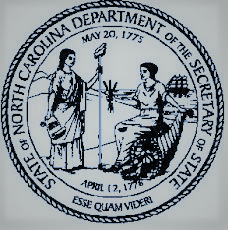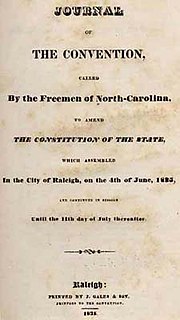Related Research Articles

Abner Nash was the second Governor of the U.S. state of North Carolina between 1781 and 1782, and represented North Carolina in the Continental Congress from 1782 to 1786.
Robert Lee Holloman was a Democratic member of the North Carolina General Assembly who represented the state's fourth Senate district, including constituents in Bertie, Chowan, Gates, Halifax, Hertford, Northampton, and Perquimans counties. Holloman lived in Ahoskie, North Carolina and was a pastor at Nebo Missionary Baptist Church in Murfreesboro. Holloman died in January 2007 after being elected in November 2006 to his third term in the state Senate. He died one day after his fellow Hertford County legislator, Howard J. Hunter, Jr. Robert Lee Holloman was the son of Daraious and Beatrice Vaughan Holloman.

The North Carolina Secretary of State is a constitutional officer in the executive branch of the government of the U.S. state of North Carolina, and is fourth in the line of succession to the office of Governor of North Carolina. Twenty-three individuals have held the office since statehood. The incumbent is Elaine Marshall, a Democrat and the first woman elected to the office.

William Hawkins was the 17th Governor of the U.S. state of North Carolina from 1811 to 1814.

The North Carolina General Assembly of 1777 met in two sessions in New Bern, North Carolina, from April 7 to May 9, 1777, and from November 15 to December 24, 1777. This was the first North Carolina legislature elected after the last provincial congress wrote the first North Carolina Constitution. This assembly elected Richard Caswell as the state's first constitutional governor.
The North Carolina General Assembly of 1779 met in three sessions in three locations in the years 1779 and 1780. The first session was held in Smithfield from May 3 to May 15, 1779; the second session in Halifax, from October 18 to November 10, 1779; the third and final session in New Bern, from January to February, 1780.

The President pro tempore of the North Carolina Senate is the highest-ranking officer of one house of the North Carolina General Assembly. The President of the Senate is the Lieutenant Governor of North Carolina, but the President pro tempore actually holds most of the power and presides in the absence of the Lt. Governor. The President pro tempore, a senior member of the party with a majority of seats, appoints senators to committees and also appoints certain members of state boards and commissions. From 1777 to 1868, North Carolina had no Lieutenant Governor, and the highest-ranking officer of the Senate was known as the "Speaker". The Speaker of the Senate was next in line if the office of Governor became vacant. This occurred on two occasions.
John Harvey was a legislative leader in the Province of North Carolina and subsequently a leader in the creation of the revolutionary movement in the province.
The Salisbury District of North Carolina, was originally one of six colonial judicial districts established in 1766 by the Governor William Tryon of the Province of North Carolina. Immediately preceding the onset of the American War of Independence in 1775, these six regions were renamed "Military districts" by the North Carolina Provincial Congress and used for organizing the North Carolina militia. The other districts were Edenton, Halifax, Hillsborough, New Bern, and Wilmington districts. The districts designation was discontinued in 1835 during the North Carolina Constitution Convention.

The government of North Carolina is divided into three branches: executive, legislative, and judicial. These consist of the Council of State, the bicameral legislature, and the state court system. The Constitution of North Carolina delineates the structure and function of the state government.
The Edenton District Brigade was an administrative division of the North Carolina militia during the American Revolutionary War (1776–1783). This unit was established by the North Carolina Provincial Congress on May 4, 1776, and disbanded at the end of the war.
North Carolina state troops in the American Revolution were the initial military units created in a transition from the Province of North Carolina under British rule to independence from British rule. Most units did not last long as such and were either transferred to the Continental Army or state militia instead.
William Skinner was a Province of North Carolina official, planter and brigadier general in Edenton District Brigade of the North Carolina militia during the American Revolution.
Thomas Wade (1720–1786) was a merchant, commander of the Anson County Regiment of North Carolina militia during the American Revolution, and senator from Anson County in the North Carolina Provincial Congress and General Assembly. Wadesboro, North Carolina was named for him.
The North Carolina General Assembly of 1780-1781 was the fourth elected legislative body of the State of North Carolina. The assembly consisted of a Senate and House of Commons that met in three sessions in at least two locations in the years 1780 and 1781. Each of the existing 50 North Carolina counties were authorized to elect one Senator and two members of the House of Commons. In addition, six districts also elected one House member each. The first two sessions were probably held in New Bern, North Carolina in April and September 1780. The third session met in Halifax from January 27, 1781 – February 13, 1781.
The North Carolina General Assembly of 1836–1837 met in Raleigh from November 21, 1836 to January 23, 1837. The assembly consisted of the 120 members of the North Carolina House of Commons and 50 senators of North Carolina Senate elected by the voters in August 1836. During the 1836 session, the legislature created Davie County, but it was not until 1842 that Davie County began sending delegates to the General Assembly. William H. Haywood, Jr was elected speaker of the House of Commons and Charles Manley was elected clerk. Hugh Waddell was elected President of the Senate and Thomas G. Stone was elected Clerk. Richard Dobbs Spaight, Jr. was the Governor in 1835 and 1836. He was elected by the previous legislature. In 1837, the Governor of North Carolina, Edward Bishop Dudley from New Hanover County, was elected, for the first time, by the people vice the legislature. The Whigs would control North Carolina politics until 1850. While in power, their notable achievements included funding railroads and roads, public education, and State chartered banks.
The North Carolina General Assembly of 1781 met in Wake Court House from June 23 to July 14, 1781. Each of the 50 North Carolina counties were allowed one Senator and two members of the House of Commons; 6 districts/boroughs towns also elected one House member each.
The North Carolina General Assembly of 1783 was the state legislature that convened in Hillsboro, North Carolina from April 18, 1783, to May 17, 1783. Members of the North Carolina Senate and the North Carolina House of Commons were elected by eligible North Carolina voters. This was the last assembly to meet during the American Revolution. Much of their time was devoted to taking care of the North Carolina soldiers that fought in the war.

The North Carolina Constitutional Convention of 1835 was a meeting of delegates elected by eligible voters in counties in the United States state of North Carolina to amend the Constitution of North Carolina written in 1776 by the Fifth North Carolina Provincial Congress. They met in Raleigh, North Carolina from June 4, 1835, to July 11, 1835, and approved several amendments to the constitution that were voted on and approved by the voters of North Carolina on November 9, 1835. These amendments improved the representation of the more populous counties in the Piedmont and western regions of the state and, for the first time, provided for the election of the governor by popular vote rather than election by the members of the General Assembly.
The North Carolina General Assembly of 1835 met in Raleigh from November 16, 1835 to December 22, 1835. The assembly consisted of the 137 members of the North Carolina House of Commons and 65 senators of North Carolina Senate elected by the voters in August 1835. This was the last assembly elected before the amendments to the Constitution of North Carolina from the North Carolina Constitutional Convention of 1835 took effect. Thus, the House of Commons included representatives from towns and the number of members of the house was greater than 120. William H. Haywood, Jr was elected speaker of the House of Commons and Charles Manley was elected clerk. William D. Mosely was elected President of the Senate and William J. Cowan was elected Clerk. Richard Dobbs Spaight, Jr. was elected the Governor by the assembly and served from December 10, 1835 to December 31, 1836. He was the last governor of North Carolina to be elected by the General Assembly.
References
- 1 2 Wheeler, John H. (1874). "The Legislative Manual and Political Register of the State of North Carolina" . Retrieved April 9, 2019.
- 1 2 Lewis, J.D. "North Carolina State House 1781". The American Revolution in North Carolina. Retrieved April 17, 2019.
- 1 2 Lewis, J.D. "North Carolina State Senators 1781". The American Revolution in North Carolina. Retrieved April 17, 2019.
- 1 2 Oiwekm William S. (1994). "Joseph Riddick". NCPEDIA. Retrieved December 13, 2019.
- 1 2 Powell, William S. (1994). "Joseph Riddick". NCPedia. Retrieved August 18, 2019.
- ↑ Harrell, Isaac Samuel. Gates County to 1860.
- ↑ "A New Nation Votes, 1787-1825". elections.lib.tufts.edu. Retrieved December 16, 2019.
- ↑ SAUNDERS, COL RECS OF NC, VOL 10, P 847
- ↑ HAUN, NC REV ARMY ACCTS, BOOK K, PART XVIII, P 2622
- ↑ WHEELER, HIST SKETCHES OF NC FROM 1584 TO 1851, VOL 2, P 160
- ↑ Gates & Perquimans County, NC - Act to Establish Dividing Line
- ↑ NC Archives, Public and Private Laws of North Carolina, 1819-22, Chapter CVIII, Page 73
- ↑ Sandra L. Almasy, comp., Gates County, North Carolina: Wills—Book 1, 1779–1807 (1984), Book 2, 1807–1838 (1985).
- "Candidate detail". OurCampaigns.com.
- "RootsWeb, Reddick"., dead link
- "Gates County Regiment, North Carolina militia" . Retrieved August 19, 2019., mentions Christopher and Kadar Reddick
- John L. Cheney, comp., North Carolina Government, 1585–1979 (1981).
- Walter Clark, ed., State Records of North Carolina, vol. 22 (1907).
- R. D. W. Connor, comp., A Documentary History of the University of North Carolina, 1776–1799, vol. 1 (1953).
- Guion G. Johnson, Ante-Bellum North Carolina (1937).
- Griffith J. McRee, Life and Correspondence of James Iredell, vol. 2 (1858).
- William C. Pool, "An Economic Interpretation of the Ratification of the Federal Constitution in North Carolina," North Carolina Historical Review 27 (1950).
- Raleigh Register, 9 Oct. 1818.
- William L. Saunders, ed., Colonial Records of North Carolina, vol. 10 (1890).